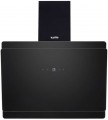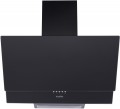Modes
Modes supported by the hood.
—
Extraction only. The device draws in the air in the room and takes it to the ventilation shaft or directly to the street. It is a very effective way to clean the air from pollution: all impurities, including odours, are simply removed. However, when the hood is operated in this mode, you must either open windows or provide adequate ventilation. Because of this, this mode is not always appropriate: for example, in the cold season, not only pollution but also heat can fly out into the chimney. Therefore, in most modern hoods, a recirculation mode is also provided.
—
Recirculation. An operating mode in which the hood does not draw air from the room but drives it through its own filters. This mode is not as effective in terms of air purification as extraction. To effectively remove odours you need to use absorbent filters, that have a limited service life. On the other hand, recirculation does not require an intensive flow of outside air, which in some situations is important — for example, in the cold season, when it is undesirable to blow out the heated air from the room.
The vast majority of modern hoods support
both modes of operation. Occasionally, some models are not compatible with carbon filters and work only in extraction mode; even rarer — devices with recirculation only mode.
Flow of air (motor)
The maximum flow of air or motor flow of air indicates the theoretical capability of the device. This parameter of the hood (motor) is measured during idle operation. By connecting the duct and working in the appropriate mode of extraction, the flow of air will be lower. However, high-performance motors will also give a high flow of air in extraction mode.
Number of speeds
The number of speeds at which the hood can operate.
The more speeds, the more accurately you can adjust the device's operating mode to a specific situation. At the same time, the vast majority of modern hoods have only three speeds which are enough for most occasions.
Ability to install carbon filter
The ability to install an additional carbon filter in the hood — in addition to the grease filter (see above).
It provides finer air purification than a grease mesh: the carbon filter is capable of retaining impurities literally at the molecular level. Due to this, it is possible to effectively clean the air from not only kitchen fumes but also odours that are not associated with smoke, steam and other relatively large impurities. However, the carbon filter has a limited service life, and it has to be changed from time to time (cleaning, in this case, is not an option).
Note that, in this case, we are talking only about the compatibility of the hood with a carbon filter. The filter itself may not be supplied. However, in many models with this function, it is available as an option (included or not included in the kit at the request of the user).
Controls
The control method provided in the hood.
—
Push-buttons. The most popular control method in modern hoods can be provided in devices of any functionality and price category — from low-cost models, where buttons directly control the motor, to high-end solutions with advanced electronic circuits.
—
Rotary knobs. Control with rotary knobs, sometimes supplemented by buttons or touch sensors. A rather specific option found mainly in high-end hoods, where rotary knobs are part of the design.
—
Slider. Control using the lever moved on the special panel. Usually, only power is regulated in this way: the farther the slider is from the neutral position, the more air the hood draws. A fairly universal control method, found in hoods of all price categories.
—
Touch controls. Control using touch panels is considered a sign of expensive high-end hoods. It is because it makes sense to use such panels mainly with advanced control electronics and they are poorly suited for low-cost devices. From a practical point of view, the touch controls are remarkable for their ease of use and ease of cleaning: a light touch is enough to give a command, and the panel itself has no slots or protrusions, making it easy to clean dirt.
Remote control
A remote control allows you to control the functions of the hood from a distance. Such a remote control will be especially convenient for those who, due to low height or health problems, find it difficult to reach for the hood itself every time. At the same time, this function affects the cost of the device, and the need for it arises relatively rarely. Therefore, the presence of a
remote control is typical mainly for rather expensive models.
Sleep timer
A timer that automatically turns off the hood after a predetermined time. With such a system, you do not need to wait until the completion of ventilation and turn off the device manually — just set the timer, and you can safely leave the kitchen on your own business; the hood will turn itself off at the right time.
Display
The hood has its own display. Usually, this is the simplest
LCD screen for two or three characters, sometimes with additional indicators. However, even such a screen makes device control more convenient and visual: it can display the current operating mode, information about the sleep timer (see Sleep timer), the status of filters (see Filter indicator), etc.
This function rarely is used in inexpensive hoods with the simplest functionality. Therefore, the display is usually a sign of an expensive and advanced model.
Energy class
This indicator characterizes how economically the hood consumes electricity. Initially, classes were marked in Latin letters from A (highest) and further down as they went down; later, improved classes A+ and A++ appeared. (the more pluses, the better). More energy-efficient models are more expensive but can pay for themselves in the process of use, especially if you have to cook often and in large quantities.

